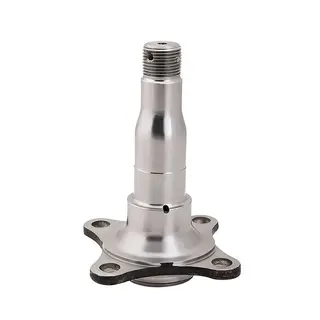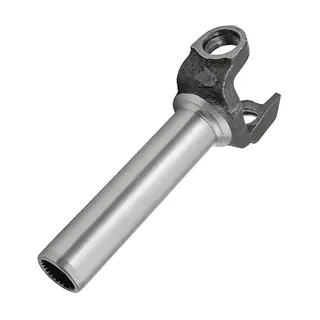In the field of metal processing, forging is a critically important process. It deforms metal plastically by applying pressure, thereby producing forgings with specific shapes and properties. In the forging process, the forging ratio is an essential parameter that cannot be ignored. It not only affects the metal's microstructure but also directly determines the mechanical performance and quality of the forging. This article will delve into the importance of the forging ratio, its impact on metal structure and properties, and how to select it appropriately.
The forging ratio is an important indicator that measures the degree of metal deformation during forging. It usually refers to the ratio of the cross-sectional area of the raw material (or preform billet) before forging to the cross-sectional area of the forged product. Simply put, the forging ratio reflects the extent to which the metal is compressed or stretched during forging.
In practice, the forging ratio can be determined in several ways:
Cross-sectional area ratio: This is the most commonly used method. For example, if the cross-sectional area of the billet before forging is A1 and the forged cross-sectional area is A2, the forging ratio R can be expressed as R = A2 / A1.
Length ratio: When the billet maintains the same shape before and after forging, the forging ratio can also be calculated using the length ratio. For example, if the original length of the billet is L1 and the length after forging is L2, the forging ratio R = L2 / L1. However, this method only applies to deformations where the shape is consistent. For shape changes, such as forging an octagonal billet into a square billet, the cross-sectional area ratio must be used.
Process forging ratio and total forging ratio: In practical production, forging often consists of multiple steps. Each step has its corresponding forging ratio, called the process forging ratio, while the total forging ratio is the product of all process ratios. For example, if a billet undergoes two forging steps, the first with a ratio of 2 and the second with a ratio of 3, the total forging ratio is 2 × 3 = 6.
The magnitude of the forging ratio has a significant impact on the metal's microstructure. During forging, as the forging ratio increases, internal porosity is gradually compressed, and cast dendrites are broken down. These microscopic changes make the metal structure denser, with finer and more uniform grains. Specifically, the impact of the forging ratio on metal microstructure is reflected in the following aspects:
Porosity compression and grain refinement: During forging, as the forging ratio increases, internal porosity is gradually compressed, and cast dendrites are broken down. These microscopic changes result in a denser structure and finer, more uniform grains. For example, after forging a steel ingot, coarse and uneven grains are broken down and transformed into fine, uniform equiaxed grains through recrystallization. This fine grain structure not only improves mechanical properties but also enhances machinability.
Uniform distribution of carbides: For high-alloy steels, such as stainless steel and high-speed steel, an increased forging ratio helps achieve uniform carbide distribution. During forging, carbide particles redistribute with metal flow, reducing clustering. For example, the forging ratio for stainless steel is generally selected as 4–6, while for high-speed steel it is 5–12. A proper forging ratio can effectively improve carbide distribution, enhancing toughness and wear resistance.
Formation of fibrous structure: As the forging ratio increases, internal impurities (such as oxides, sulfides, etc.) redistribute along the deformation direction, forming a so-called fibrous structure. This structure causes directional differences in mechanical properties, with properties along the fiber direction being superior to those perpendicular to it. For example, when the forging cross-section ratio exceeds 3–4, fibrous structures gradually become apparent, and transverse mechanical ductility decreases sharply, resulting in anisotropy of the forging. Therefore, reasonable selection of the forging ratio is crucial for controlling the formation and distribution of fibrous structures.
The forging ratio not only affects the metal's microstructure but also directly determines its mechanical properties. A proper forging ratio can significantly enhance mechanical performance, while an excessively high or low ratio may lead to substandard properties. Specifically, the influence of the forging ratio on mechanical properties is reflected in the following aspects:
Improvement of longitudinal and transverse mechanical properties: As the forging ratio increases, both longitudinal and transverse properties of the metal improve. This is because the increase in forging ratio compresses internal porosity, refines grains, and densifies the structure. For example, for high-quality carbon structural steel and alloy structural steel, the forging ratio of shaft-type forgings on the hammer should be ≥3; the forging ratio of ring-type forgings is generally ≥3; and the upsetting forging ratio of disc-type forgings should be ≥3. These appropriate forging ratios ensure the mechanical properties meet design requirements.
Changes in ductility: When the forging cross-section ratio exceeds 3–4, fibrous structures gradually appear, and the ductility of transverse mechanical properties decreases sharply. This is because the fibrous structure limits deformation in the transverse direction. Therefore, in designing the forging process, the forging ratio must be reasonably controlled to avoid excessive anisotropy caused by fibrous structures.
Control of anisotropy: Selecting the forging ratio is vital for controlling anisotropy. If the forging ratio is too small, the forging may not meet performance requirements; if it is too large, it increases forging workload and may cause anisotropy. For some high-alloy steel billets, a larger forging ratio is needed to eliminate structural defects and achieve uniform carbide distribution. However, an excessively high ratio increases forging difficulty and cost and may lead to anisotropy. Therefore, in practical production, the forging ratio must be reasonably selected according to the intended use and performance requirements of the forging.
Selecting a reasonable forging ratio is key to ensuring forging quality and simplifying the forging process. In practical production, forging ratio selection requires comprehensive consideration of factors including metal type, forging application, and forging process. Some basic principles include:
Ensuring forging performance requirements: The forging ratio should primarily satisfy the mechanical performance requirements. For example, for high-quality carbon structural steel and alloy structural steel, the forging ratio of shaft-type forgings should be ≥3; ring-type forgings generally ≥3; and disc-type forgings' upsetting forging ratio ≥3. These ratios ensure that mechanical properties meet design requirements.
Choosing the smallest feasible ratio: Under the premise of meeting performance requirements, the forging ratio should be as small as possible. A smaller ratio reduces forging workload and production costs. For example, for simple forgings, the ratio can be slightly reduced as long as performance is not compromised.
Considering process feasibility: The forging ratio should also account for the feasibility of the forging process. For large forgings, the ratio must consider equipment capacity and process complexity. Excessive ratios may exceed equipment limits or complicate the process, increasing cost and risk.
Comprehensive consideration of metal structure and properties: The forging ratio should be selected by considering the metal's structure and properties. For high-alloy steels, such as stainless steel and high-speed steel, the ratio must consider defect elimination and uniform carbide distribution. Therefore, the selection must be based on metal type and required performance.
In practical production, the forging ratio must be adjusted according to specific conditions. Important considerations include:
Importance of forging state: For large forgings, the forging state (such as strain field and temperature field) is more important than the simple forging ratio. For example, forging with very small increments may not achieve the same compaction in the core as forging with large reductions. Therefore, optimizing the forging state is crucial for ensuring forging quality.
Application of computer simulation: With the development of computer technology, simulation has been widely applied in forging process design. Simulation can accurately predict deformation states and optimize the forging ratio. For example, in die forging, simulations consider not only the forging ratio but also "fields" such as strain and temperature distribution, providing a multidimensional view of the complex deformation process.
Final microstructure inspection and NDT: The choice of forging ratio should also be verified with final microstructure inspection and non-destructive testing. For example, clients may request that "the forging ratio should be above a certain value," but the critical factor is the final inspection and testing results. Only through strict inspection and testing can the forging quality meet design requirements.
The forging ratio is a key parameter in forging, significantly affecting the metal's microstructure and mechanical properties. Proper selection of the forging ratio can improve mechanical performance, simplify the forging process, and reduce production costs. In practical production, selecting the forging ratio requires comprehensive consideration of metal type, forging application, and process conditions. By choosing a reasonable forging ratio, the quality and performance of forgings can be effectively enhanced to meet the requirements of various applications.
In short, the forging ratio plays a critical role in the forging process. Only by thoroughly understanding its definition, influencing factors, and effects on metal microstructure and properties can the forging ratio be properly selected in production, ensuring smooth forging processes and high-quality forged products.



